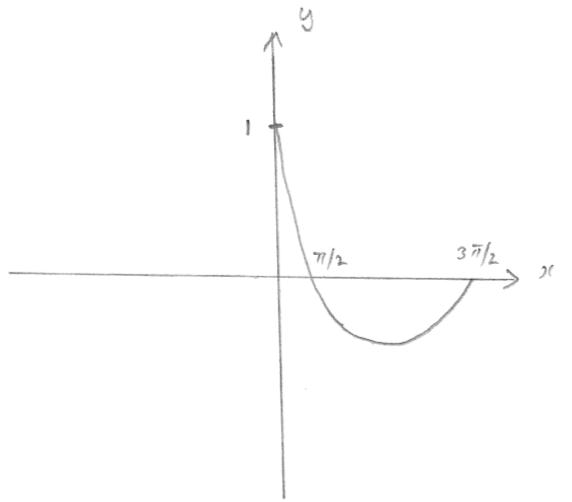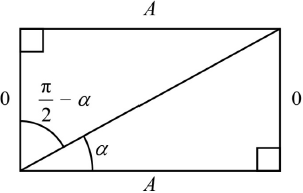Question
The function f is defined on the domain \(\left[ {0,\,\frac{{3\pi }}{2}} \right]\) by \(f(x) = {e^{ – x}}\cos x\) .
State the two zeros of f .
Sketch the graph of f .
The region bounded by the graph, the x-axis and the y-axis is denoted by A and the region bounded by the graph and the x-axis is denoted by B . Show that the ratio of the area of A to the area of B is
\[\frac{{{e^\pi }\left( {{e^{\frac{\pi }{2}}} + 1} \right)}}{{{e^\pi } + 1}}.\]
▶️Answer/Explanation
Markscheme
\({e^{ – x}}\cos x = 0\)
\( \Rightarrow x = \frac{\pi }{2},{\text{ }}\frac{{3\pi }}{2}\) A1
[1 mark]
 A1
A1
Note: Accept any form of concavity for \(x \in \left[ {0,\frac{\pi }{2}} \right]\).
Note: Do not penalize unmarked zeros if given in part (a).
Note: Zeros written on diagram can be used to allow the mark in part (a) to be awarded retrospectively.
[1 mark]
attempt at integration by parts M1
EITHER
\(I = \int {{{\text{e}}^{ – x}}\cos x{\text{d}}x = – {{\text{e}}^{ – x}}\cos x{\text{d}}x – \int {{{\text{e}}^{ – x}}\sin x{\text{d}}x} } \) A1
\( \Rightarrow I = – {{\text{e}}^{ – x}}\cos x{\text{d}}x – \left[ { – {{\text{e}}^{ – x}}\sin x + \int {{{\text{e}}^{ – x}}\cos x{\text{d}}x} } \right]\) A1
\( \Rightarrow I = \frac{{{{\text{e}}^{ – x}}}}{2}(\sin x – \cos x) + C\) A1
Note: Do not penalize absence of C.
OR
\(I = \int {{{\text{e}}^{ – x}}\cos x{\text{d}}x = {{\text{e}}^{ – x}}\sin x + \int {{{\text{e}}^{ – x}}\sin x{\text{d}}x} } \) A1
\(I = {{\text{e}}^{ – x}}\sin x – {{\text{e}}^{ – x}}\cos x – \int {{{\text{e}}^{ – x}}\cos x{\text{d}}x} \) A1
\( \Rightarrow I = \frac{{{{\text{e}}^{ – x}}}}{2}(\sin x – \cos x) + C\) A1
Note: Do not penalize absence of C.
THEN
\(\int_0^{\frac{\pi }{2}} {{{\text{e}}^{ – x}}\cos x{\text{d}}x = \left[ {\frac{{{{\text{e}}^{ – x}}}}{2}(\sin x – \cos x)} \right]} _0^{\frac{\pi }{2}} = \frac{{{{\text{e}}^{ – \frac{\pi }{2}}}}}{2} + \frac{1}{2}\) A1
\(\int_{\frac{\pi }{2}}^{\frac{{3\pi }}{2}} {{{\text{e}}^{ – x}}\cos x{\text{d}}x = \left[ {\frac{{{{\text{e}}^{ – x}}}}{2}(\sin x – \cos x)} \right]_{\frac{\pi }{2}}^{\frac{{3\pi }}{2}} = – \frac{{{{\text{e}}^{ – \frac{{3\pi }}{2}}}}}{2} – \frac{{{{\text{e}}^{ – \frac{\pi }{2}}}}}{2}} \) A1
ratio of A:B is \(\frac{{\frac{{{{\text{e}}^{ – \frac{\pi }{2}}}}}{2} + \frac{1}{2}}}{{\frac{{{{\text{e}}^{ – \frac{{3\pi }}{2}}}}}{2} + \frac{{{{\text{e}}^{ – \frac{\pi }{2}}}}}{2}}}\)
\( = \frac{{{{\text{e}}^{\frac{{3\pi }}{2}}}\left( {{{\text{e}}^{ – \frac{\pi }{2}}} + 1} \right)}}{{{{\text{e}}^{\frac{{3\pi }}{2}}}\left( {{{\text{e}}^{ – \frac{{3\pi }}{2}}} + {{\text{e}}^{ – \frac{\pi }{2}}}} \right)}}\) M1
\( = \frac{{{{\text{e}}^\pi }\left( {{{\text{e}}^{\frac{\pi }{2}}} + 1} \right)}}{{{{\text{e}}^\pi } + 1}}\) AG
[7 marks]
Examiners report
Many candidates stated the two zeros of f correctly but the graph of f was often incorrectly drawn. In (c), many candidates failed to realise that integration by parts had to be used twice here and even those who did that often made algebraic errors, usually due to the frequent changes of sign.
Many candidates stated the two zeros of f correctly but the graph of f was often incorrectly drawn. In (c), many candidates failed to realise that integration by parts had to be used twice here and even those who did that often made algebraic errors, usually due to the frequent changes of sign.
Many candidates stated the two zeros of f correctly but the graph of f was often incorrectly drawn. In (c), many candidates failed to realise that integration by parts had to be used twice here and even those who did that often made algebraic errors, usually due to the frequent changes of sign.
Question
Consider the functions \(f(x) = \tan x,{\text{ }}0 \le \ x < \frac{\pi }{2}\) and \(g(x) = \frac{{x + 1}}{{x – 1}},{\text{ }}x \in \mathbb{R},{\text{ }}x \ne 1\).
Find an expression for \(g \circ f(x)\), stating its domain.
Hence show that \(g \circ f(x) = \frac{{\sin x + \cos x}}{{\sin x – \cos x}}\).
Let \(y = g \circ f(x)\), find an exact value for \(\frac{{{\text{d}}y}}{{{\text{d}}x}}\) at the point on the graph of \(y = g \circ f(x)\) where \(x = \frac{\pi }{6}\), expressing your answer in the form \(a + b\sqrt 3 ,{\text{ }}a,{\text{ }}b \in \mathbb{Z}\).
Show that the area bounded by the graph of \(y = g \circ f(x)\), the \(x\)-axis and the lines \(x = 0\) and \(x = \frac{\pi }{6}\) is \(\ln \left( {1 + \sqrt 3 } \right)\).
▶️Answer/Explanation
Markscheme
\(g \circ f(x) = \frac{{\tan x + 1}}{{\tan x – 1}}\) A1
\(x \ne \frac{\pi }{4},{\text{ }}0 \le x < \frac{\pi }{2}\) A1
[2 marks]
\(\frac{{\tan x + 1}}{{\tan x – 1}} = \frac{{\frac{{\sin x}}{{\cos x}} + 1}}{{\frac{{\sin x}}{{\cos x}} – 1}}\) M1A1
\( = \frac{{\sin x + \cos x}}{{\sin x – \cos x}}\) AG
[2 marks]
METHOD 1
\(\frac{{{\text{d}}y}}{{{\text{d}}x}} = \frac{{(\sin x – \cos x)(\cos x – \sin x) – (\sin x + \cos x)(\cos x + \sin x)}}{{{{(\sin x – \cos x)}^2}}}\) M1(A1)
\(\frac{{{\text{d}}y}}{{{\text{d}}x}} = \frac{{(2\sin x\cos x – {{\cos }^2}x – {{\sin }^2}x) – (2\sin x\cos x + {{\cos }^2}x + {{\sin }^2}x)}}{{{{\cos }^2}x + {{\sin }^2}x – 2\sin x\cos x}}\)
\( = \frac{{ – 2}}{{1 – \sin 2x}}\)
Substitute \(\frac{\pi }{6}\) into any formula for \(\frac{{{\text{d}}y}}{{{\text{d}}x}}\) M1
\(\frac{{ – 2}}{{1 – \sin \frac{\pi }{3}}}\)
\( = \frac{{ – 2}}{{1 – \frac{{\sqrt 3 }}{2}}}\) A1
\( = \frac{{ – 4}}{{2 – \sqrt 3 }}\)
\( = \frac{{ – 4}}{{2 – \sqrt 3 }}\left( {\frac{{2 + \sqrt 3 }}{{2 + \sqrt 3 }}} \right)\) M1
\( = \frac{{ – 8 – 4\sqrt 3 }}{1} = – 8 – 4\sqrt 3 \) A1
METHOD 2
\(\frac{{{\text{d}}y}}{{{\text{d}}x}} = \frac{{(\tan x – 1){{\sec }^2}x – (\tan x + 1){{\sec }^2}x}}{{{{(\tan x – 1)}^2}}}\) M1A1
\( = \frac{{ – 2{{\sec }^2}x}}{{{{(\tan x – 1)}^2}}}\) A1
\( = \frac{{ – 2{{\sec }^2}\frac{\pi }{6}}}{{{{\left( {\tan \frac{\pi }{6} – 1} \right)}^2}}} = \frac{{ – 2\left( {\frac{4}{3}} \right)}}{{{{\left( {\frac{1}{{\sqrt 3 }} – 1} \right)}^2}}} = \frac{{ – 8}}{{{{\left( {1 – \sqrt 3 } \right)}^2}}}\) M1
Note: Award M1 for substitution \(\frac{\pi }{6}\).
\(\frac{{ – 8}}{{{{\left( {1 – \sqrt 3 } \right)}^2}}} = \frac{{ – 8}}{{\left( {4 – 2\sqrt 3 } \right)}}\frac{{\left( {4 + 2\sqrt 3 } \right)}}{{\left( {4 + 2\sqrt 3 } \right)}} = – 8 – 4\sqrt 3 \) M1A1
[6 marks]
Area \(\left| {\int_0^{\frac{\pi }{6}} {\frac{{\sin x + \cos x}}{{\sin x – \cos x}}{\text{d}}x} } \right|\) M1
\( = \left| {\left[ {\ln \left| {\sin x – \cos x} \right|} \right]_0^{\frac{\pi }{6}}} \right|\) A1
Note: Condone absence of limits and absence of modulus signs at this stage.
\( = \left| {\ln \left| {\sin \frac{\pi }{6} – \cos \frac{\pi }{6}} \right| – \ln \left| {\sin 0 – \cos 0} \right|} \right|\) M1
\( = \left| {\ln \left| {\frac{1}{2} – \frac{{\sqrt 3 }}{2}} \right| – 0} \right|\)
\( = \left| {\ln \left( {\frac{{\sqrt 3 – 1}}{2}} \right)} \right|\) A1
\( = – \ln \left( {\frac{{\sqrt 3 – 1}}{2}} \right) = \ln \left( {\frac{2}{{\sqrt 3 – 1}}} \right)\) A1
\( = \ln \left( {\frac{2}{{\sqrt 3 – 1}} \times \frac{{\sqrt 3 + 1}}{{\sqrt 3 + 1}}} \right)\) M1
\( = \ln \left( {\sqrt 3 + 1} \right)\) AG
[6 marks]
Total [16 marks]
Examiners report
[N/A]
[N/A]
[N/A]
[N/A]
Question
Show that \(\sin \left( {\theta + \frac{\pi }{2}} \right) = \cos \theta \).
Consider \(f(x) = \sin (ax)\) where \(a\) is a constant. Prove by mathematical induction that \({f^{(n)}}(x) = {a^n}\sin \left( {ax + \frac{{n\pi }}{2}} \right)\) where \(n \in {\mathbb{Z}^ + }\) and \({f^{(n)}}(x)\) represents the \({{\text{n}}^{{\text{th}}}}\) derivative of \(f(x)\).
▶️Answer/Explanation
Markscheme
\(\sin \left( {\theta + \frac{\pi }{2}} \right) = \sin \theta \cos \frac{\pi }{2} + \cos \theta \sin \frac{\pi }{2}\) M1
\( = \cos \theta \) AG
Note: Accept a transformation/graphical based approach.
[1 mark]
consider \(n = 1,{\text{ }}f'(x) = a\cos (ax)\) M1
since \(\sin \left( {ax + \frac{\pi }{2}} \right) = \cos ax\) then the proposition is true for \(n = 1\) R1
assume that the proposition is true for \(n = k\) so \({f^{(k)}}(x) = {a^k}\sin \left( {ax + \frac{{k\pi }}{2}} \right)\) M1
\({f^{(k + 1)}}(x) = \frac{{{\text{d}}\left( {{f^{(k)}}(x)} \right)}}{{{\text{d}}x}}\;\;\;\left( { = a\left( {{a^k}\cos \left( {ax + \frac{{k\pi }}{2}} \right)} \right)} \right)\) M1
\( = {a^{k + 1}}\sin \left( {ax + \frac{{k\pi }}{2} + \frac{\pi }{2}} \right)\) (using part (a)) A1
\( = {a^{k + 1}}\sin \left( {ax + \frac{{(k + 1)\pi }}{2}} \right)\) A1
given that the proposition is true for \(n = k\) then we have shown that the proposition is true for \(n = k + 1\). Since we have shown that the proposition is true for \(n = 1\) then the proposition is true for all \(n \in {\mathbb{Z}^ + }\) R1
Note: Award final R1 only if all prior M and R marks have been awarded.
[7 marks]
Total [8 marks]
Examiners report
[N/A]
[N/A]
Question
Show that \(\cot \alpha = \tan \left( {\frac{\pi }{2} – \alpha } \right)\) for \(0 < \alpha < \frac{\pi }{2}\).
Hence find \(\int_{\tan \alpha }^{\cot \alpha } {\frac{1}{{1 + {x^2}}}{\text{d}}x,{\text{ }}0 < \alpha < \frac{\pi }{2}} \).
▶️Answer/Explanation
Markscheme
EITHER
use of a diagram and trig ratios
eg,

\(\tan \alpha = \frac{O}{A} \Rightarrow \cot \alpha = \frac{A}{O}\)
from diagram, \(\tan \left( {\frac{\pi }{2} – \alpha } \right) = \frac{A}{O}\) R1
OR
use of \(\tan \left( {\frac{\pi }{2} – \alpha } \right) = \frac{{\sin \left( {\frac{\pi }{2} – \alpha } \right)}}{{\cos \left( {\frac{\pi }{2} – \alpha } \right)}} = \frac{{\cos \alpha }}{{\sin \alpha }}\) R1
THEN
\(\cot \alpha = \tan \left( {\frac{\pi }{2} – \alpha } \right)\) AG
[1 mark]
\(\int_{\tan \alpha }^{\cot \alpha } {\frac{1}{{1 + {x^2}}}{\text{d}}x} = [\arctan x]_{\tan \alpha }^{\cot \alpha }\) (A1)
Note: Limits (or absence of such) may be ignored at this stage.
\( = \arctan (\cot \alpha ) – \arctan (\tan \alpha )\) (M1)
\( = \frac{\pi }{2} – \alpha – \alpha \) (A1)
\( = \frac{\pi }{2} – 2\alpha \) A1
[4 marks]
Examiners report
This was generally well done.
This was generally well done. Some weaker candidates tried to solve part (b) through use of a substitution, though the standard result \(\arctan x\) was well known. A small number used \(\arctan x + c\) and went on to obtain an incorrect final answer.
